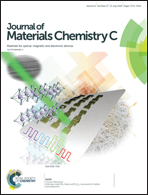Fluorescence-enhancing film sensor for highly effective detection of Bi3+ ions based on SiO2 inverse opal photonic crystals†
Abstract
Herein, we report Rhodamine 6G derivative-infiltrated SiO2 inverse opal photonic crystals (IOPC) as a fluorescence-enhancing film sensor for the detection of Bi3+ ions. In the presence of Bi3+ ions, the as-constructed sensor emits strong fluorescence at a wavelength of 553 nm due to the coordination interaction between the derivative molecules and Bi3+ ions. The fluorescence intensity is significantly enhanced by the slow photon effect of the photonic crystals when the emission wavelength overlaps with the blue band edge of the photonic stopband of the selected IOPC. This fluorescence enhancement improves the detection sensitivity of the sensor for Bi3+ ions and its limit of detection is 0.1 nM. The interconnected macroporous structure of inverse opal with a high surface area endows the sensor with a quick fluorescence response of under 30 s. This sensor exhibits good selectivity and has no interference by other metal ions due to the specific interaction between the derivative molecules and Bi3+ ions. Furthermore, the sensor can be reactivated by CH3COO−, which is used as a competing ligand to release Bi3+ ions from the coordination complex. Therefore, the as-constructed fluorescence-enhancing IOPC sensor realizes highly effective detection of Bi3+ ions with high sensitivity, quick response, excellent selectivity and convenient reusability and can be used to detect Bi3+ ions in drugs, which provides a platform for the design of novel fluorescence sensing materials.



 Please wait while we load your content...
Please wait while we load your content...